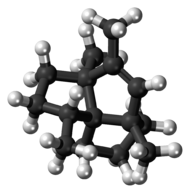Isocomene

| |

| |
| Names | |
|---|---|
| IUPAC name
(3aS,5aS,8aR)-1,3a,4,5a-Tetramethyl-1,2,3,3a,5a,6,7,8-octahydrocyclopenta[c]pentalene
| |
| Identifiers | |
3D model (JSmol)
|
|
| ChemSpider | |
PubChem CID
|
|
| UNII | |
CompTox Dashboard (EPA)
|
|
| |
| |
| Properties | |
| C15H24 | |
| Molar mass | 204.357 g·mol−1 |
Except where otherwise noted, data are given for materials in their standard state (at 25 °C [77 °F], 100 kPa).
| |
Isocomene is a sesquiterpene first isolated from the perennial herb southern goldenbush (Isocoma wrightii),[1] from which it derives its name. Its unusual structure consisting of three fused cyclopentane rings was first described by Zalkow et al. in 1977.[1] The first total synthesis of isocomene was published by M.C. Pirrung in 1979.[2] The key steps are a photocatalyzed intramolecular [2 + 2] cycloaddition reaction followed by a rearrangement reaction which forms three contiguous chiral centers.[3]
References[edit]
- ^ a b Zalkow, L. H; Harris, R. N; Van Derveer, D; Bertrand, J. A (1977). "Isocomene: A novel sesquiterpene from Isocoma Wrightii. X-Ray crystal structure of the corresponding diol". Journal of the Chemical Society, Chemical Communications (13): 456. doi:10.1039/C39770000456.
- ^ Michael C. Pirrung (1979). "Total synthesis of (±)-isocomene". Journal of the American Chemical Society. 101 (23): 7130–7131. doi:10.1021/ja00517a087.
- ^ Nicolaou, K. C.; E. J. Sorensen (1996). Classics in Total Synthesis. Weinheim, Germany: VCH. p. 221. ISBN 3-527-29284-5.
